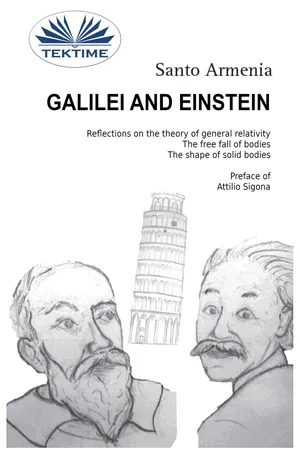
Galilei And Einstein
Reflections On The Theory Of General Relativity. The Free Fall Of Bodies.
- English
- ePUB (mobile friendly)
- Available on iOS & Android
Galilei And Einstein
Reflections On The Theory Of General Relativity. The Free Fall Of Bodies.
About This Book
We had studied Einstein's Theory of General relativity starting from elementary phenomena, together with the Galileo's principle on free fall of bodies that represent his precondition. We underlined the discrepancy of Galileo's principle, as the mass of the test body is not being subtract from the mass of the earth, and because the reciprocal attraction between the bodies has not been evaluated. Furthermore, we highlight that the free fall takes place along radial vertical lines that are not parallel. Finally, we verify the consequence of the shape of solid bodies for Galileo's principle and Einstein's theory, Archimedes' principle and the weighing (mass) of the bodies.
Starting from elementary phenomena we study Einstein's theory of general relativity, together with Galileo's principle on free fall of bodies that represent his precondition. Galileo's principle estimates that all objects fall at a constant acceleration due to gravity regardless of their mass. On the contrary, we establish the non-effectiveness of that Galileo's principle as the mass of the test body is not being subtract from the mass of the earth (incorrectly thought to be constant) and moreover for not having been evaluated the reciprocal attraction of the bodies (superposition of effects). Likewise, we highlight that the free fall takes place along radial vertical lines that are not parallel. We study the shape of solid bodies, for which bodies that have the same mass but different shape (except from sphere, equilateral cylinder and cube) when varying their position on the reference plane they have different weight: a body a mass, a body infinite weight. Therefore, we verify the consequence of the shape of solid bodies according to the Galileo's principle (that is not effective) and for the confutation of Einstein's theory, Archimedes' principle and the weighing (mass) of the bodies. PUBLISHER: TEKTIME
Frequently asked questions
Information
Table of contents
- Preface
- Introduction
- Chapter I Evolution
- Chapter II Premises
- Chapter III Elementary observations
- Chapter IV Principles of classic physics
- Chapter V First reflection on the theory of general relativity
- Chapter VI Ordinary physics
- Chapter VII A second consideration on the theory of general relativity
- Chapter VIII The shape of solid bodies
- Conclusion
- Epilogue
- Appendix A
- Appendix B
- Appendix C
- Thanks and acknowledgements
- Note